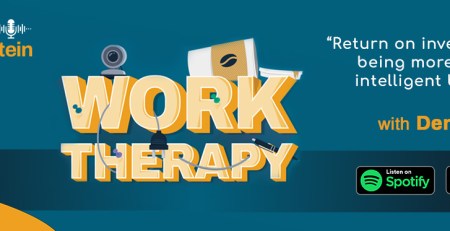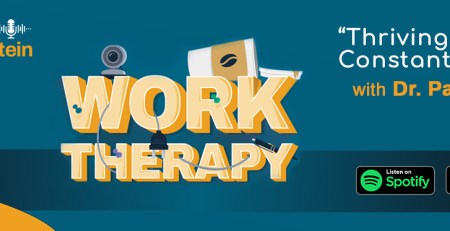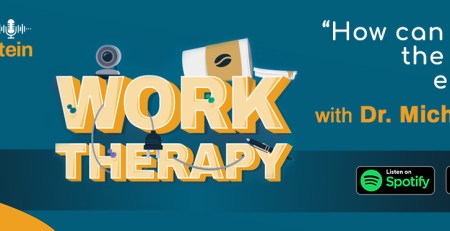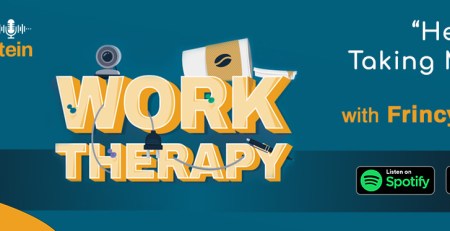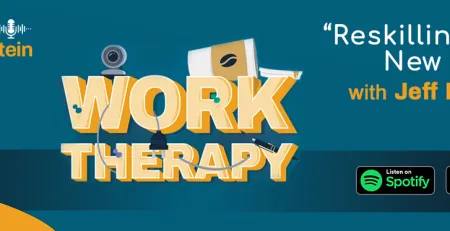Work Therapy: You don’t have to be everyone, everywhere, all at once
In this week’s episode of Work Therapy with Dr. Steven Stein, we chat with Dr. Roger Pearman, an expert in the field of personality types. Roger is also the author of MHS’ Pearman Personality Integrator, a ground-breaking tool that brings a new model of understanding and development to the field of personality type.
We discuss how we can balance our “home base” personality with our “situational” personality. We’ll talk about how any of us can be Batman in the office and Bruce Wayne at the dinner table… or maybe the other way around?
DR. STEIN: Is there someone at work you just don’t vibe with, or maybe you feel like you have to put on a face at work just to blend in? It can be really tricky to balance your needs as an individual with the culture of your workplace. How do you stay genuine and professional? I’m Dr. Steven Stein. I’m a clinical psychologist and founder of MHS, a leading developer of innovative scientific assessments in the talent development space and beyond. I’m here to tell you that work sucks sometimes. It does. I can admit it, but it doesn’t have to.
DR. STEIN: In Work Therapy, we speak with experts from diverse backgrounds helping us wade through some of the most common issues people have on the job. We learn how to go beyond just surviving at work and learn how to start thriving. Because if work sucks, how can we fix it? Today’s episode is called You don’t have to be everyone everywhere all at once, and I’ll be talking to Dr. Roger Pearman about personality. Whether they’re ours or someone else’s, personality traits and types can make a huge impact on our work lives.
DR STEIN: What really fascinates me is all the different facets of our personalities, the way they develop over time, and the different ways we choose to present our personality in different circumstances. Roger is the managing partner at TalentTelligent and president and co-founder of TeamTelligent, a company dedicated to providing teams with intelligence about the use of individual strengths and talents for team effectiveness. Roger is also author of the Pearman Personality Integrator, a groundbreaking tool that brings a new model of understanding and development to the field of personality type.
DR. STEIN: A little later, Roger will explain how we can balance our home base personality with our situational personality. We’ll dig in to how any of us can be Batman in the office and Bruce Wayne at the dinner table, or maybe the other way around. Welcome, Roger. Great to have you here on our podcast. It’s been a while since we last connected, but great to see you again and thank you for joining us.
ROGER: Thanks for the invitation, Steve. I look forward to the conversation.
DR. STEIN: Today, we’re going to talk about personality, and I guess some of the issues people run into at work that relate to personality. We often hear about or talk about these as personality types. Can you tell us a bit about that? What are these personality types and how do they express themselves?
ROGER: It’s interesting, Steve, the whole issue of personality traits, for example, versus types has been one of those ongoing debated issues in the field. From a type perspective, the notion of type is really that there are habits of mind that we lean in as a persistent way of attending to the challenges we face.
ROGER: Those are somewhat more fluid, if you will, than a trait. From a type perspective, what we know is a person has a home base and because there are other resources that they can pull on, psychologically speaking, they make the shift that they need to adapt to the challenge that they have, but return back to that home base. Type is a generous way of thinking about the way behavior evolves within an individual and how they behave throughout their lifetime.
DR. STEIN: Maybe give me a couple more examples of this home base so people understand what is this home base.
ROGER: Sure. From the frame of type that the Pearman Personality Integrator is based on, we would say that there are eight primary cores, and the eight have to do with how we both extrovert, a sensing orientation, which is really focused on the present here and now, or extrovert, an intuiting perception, which is about how we make associations in our environment and see trends and patterns around us, or we tend to be very expressive and demonstrative of seeking to connect with others, which we would say is a more extroverted feeling approach.
ROGER: Likewise, we know there’s an inner world. In that inner world we say, well, the introverted sensing part of us is very concerned about the details and how details get anchored, or the introverted intuiting part of us is looking for and anticipating how things may unfold. The introverted thinking part of each and every one of us wants to do a kind of pro/con analysis and create an internal grid about the options that we may be facing and weighing those options in a very analytical way.
ROGER: The introverted feeling part of us says there are values and there are elements of meaning that I need to find and need to act on because that’s how I align myself with the world. Let’s say an extroverted sensor who’s very focused in the here and now and wants to get the details straight and is very action oriented, who’s engaged with an extroverted thinker who’s analyzing and critiquing. The two may unintentionally feel like they’re in an argument, when in fact all they’re doing is expressing their natural, if you will, strength and their natural way of coming at the world.
ROGER: Those very important capabilities of, if you will, being empathetically attuned to other people enables us then to bridge those differences in a most constructive way, as opposed to seeing them as inherently at odds. And now instead of walking away feeling like, well, that’s a very difficult person to work with, we realize that’s just a different person and they have a way of doing things which I can appreciate and a skill that I can acknowledge is different from my own, which really together enables us to work more effectively on whatever project or task or activity that we’re engaged in.
DR. STEIN: That really goes into where I was going with my next question in terms of why certain people don’t fit in terms of what they say is their personality. What you’ve said here is that we assess them, we get a good idea of where they’re coming from, a descriptor of their personality. They have this aha moment where they say, okay, well, I’m just different from that other person. What do we do with that person to have them actually change in terms of either seeing the other person differently or behaving differently when they’re around that person? What do you do? Where do you go from there?
ROGER: Well, let’s talk about several conditions. One is let’s say I’m an individual who’s eager to be self-aware and eager to understand those around me. As a result of that, I do things like questionnaires, like the Pearman Personality Integrator or the EQ-i 2.0 or other things to sort of become increasingly self-aware because I realize there are differences all around me and I’d like to understand those. Well, if I’m in that space when I see differences, I’m in a space of curiosity.
ROGER: I’m in a space of wanting to acknowledge and understand those differences and really wanting to find a constructive bridge between the two of us so that we work collaboratively together. Let’s take another condition where perhaps I’m not so self-aware and I just show up. I do my job and the other person does his or her job. I just see them as being different, and I even interpret some of their behavior as difficult.
ROGER: Well, it could well be that if I have a good manager who says, these two are very talented people, but very different people and I need to help them bridge these differences that they present in a constructive way, then as the manager or coach, I would work on their interpersonal savvy skills to say, look, this other person does do things very differently from you, and here’s some suggestions that you might take under your hat to work with that person whose differences we can reasonably predict.
DR. STEIN: Are there some personality types that lead to more disagreement than others?
ROGER: It’s interesting, there are some differences that seem to have bigger conflicts than others. There are some differences that require more energy to deal with because of… Let’s take an extroverted versus introverted difference.
ROGER: If you could take a person who’s very naturally engaged in sharing ideas and possibilities and they see associations and alternatives all the time, this extroverted intuitive for whom the horizon is always emerging and there’s always a new set of possibilities to discuss can be absolutely exhausting to the introverted sensor who wants to be precise, exact, who wants to make sure that the information is very detail oriented.
ROGER: They do not want to hear about one more possibility. That kind of difference can create a lot of negative energy between people if they don’t understand what’s going on.
DR. STEIN: I want to get back to personality testing again. Personality testing tends to make the news for better or worse over time, whether it’s criticized, whether it’s praised. And most recently, I think there was an article about personality testing in The New York Times and the issue, it’s one of the more positive ones, I guess. The idea being post-COVID, people are finding personality tests more important as we get a remote workplace. How do you see personality and personality testing fitting into this?
ROGER: That was an interesting piece that you just referred to. The problem that we all know… I say we, meaning those of us in this professional arena. We know that the moment you start making predictions based on scores of an assessment, you’re in trouble. Human beings surprise us in all kinds of ways. When I’m answering questions about what I believe to be true for me, those aren’t the same questions that I’m being asked to answer that says, if you were in the following situation, what would you do? 99% of all personality questions are asking questions of description about oneself.
ROGER: I’m giving you my self-image. I’m telling you when I say I believe I do XYZ, I’m painting a picture for you of how I believe I am. Now, it turns out that often those self-images do show up as one might expect, but to rely too much on that is where people get into trouble in hiring. Because you really want to understand the different style that a person has, but you don’t want to take that too far to say, well, if this person likes to be analytical, gee whiz, we need an analytical person in this job, so let’s hire them.
ROGER: Well, hold on a minute, just because they like to be analytical doesn’t mean they’re any good at it. The next question is not only what is my stylistic pattern, which personality gives us a hint into, the question becomes, what are the kinds of behaviors that bring to the table that requires the kind of analysis necessary for job hiring purposes?
DR. STEIN: Where do organizations and hiring teams go wrong at this point?
ROGER: People who try to do a shortcut, organizations who try to shortcut and say, well, look, if you came out a certain pattern on this personality tool, we know that pattern does best in our organizations. We’re going to hire people with this pattern. Well, they’ll find that that only works a small percentage of the time. Because when people show up at work, they bring their whole selves and their whole selves were not reported on that personality questionnaire or that personality tool.
ROGER: A great mistake gets made in my view when people presume that because a person had a certain personality profile, that it follows she or he is going to be effective at certain kinds of things. I read these articles like you, and I ponder, how can we help organizations understand that the science of personality is pretty doggone good?
ROGER: And by the way, that science has informed us that there are better ways of using personality data in helping make decisions, not as a singular source of data, but as an additive data piece to feed into the decisions you make about who’s to be hired for what and when. It’s interesting to see how it evolves in the public press. I do realize that people, they want simple answers. Organizations want cost-effective answers. I would say, you know what? The most cost-effective answer is using the best science.
ROGER: You use the best science, and by golly, not only will you hire the right people, but you will find that you’ve used your resources well and not wasted money on simple solutions.
DR. STEIN: It seems like as workplaces get more diverse in many different ways, we have to really up the ante of leadership. We’ve got to put in additional training for our leaders today to understand these different personality types and styles and helping people get along together better in the workplace. One of the other things I want to ask you about, Roger, is that we all hear a lot about personality being fixed or some people talking about personality being fixed, but yet you can choose how you show up at work. What’s the relationship between the situation and personality?
ROGER: I believe it’s the case, Steven, and I’ve really tried to see if there’s any other instrument on the planet that does this, and I haven’t found it yet. The Pearman is, to my knowledge, the only one that asks individuals to think about, what is your really most comfortable self and what is it that you’re required to demonstrate in terms of how you have to show up? Now, there are some who say, well, if there’s a big difference there, that’s going to lead to all kinds of problems. And I would contend, maybe, maybe not.
ROGER: It depends on the resilience and the flexibility of the individual as to how much that difference between my most comfortable self and what the workplace requires of me may or may not create a lot of difficulty for an individual. One of the beauties of the Pearman with the flexibility index is that we’re able to get a handle on what’s feeding one’s flexibility and can the individual enrich their flexibility, so that if they’re in situations at work that are calling upon things in their approach to life that’s really very, very different from what’s natural, they have the energies and the resources to do that and to do it effectively.
ROGER: We all know that there are certain elements of our personality that are baked into who we are when we arrived. There are things that we polish as we learn and grow, and we accentuate for one reason or the other just in the nature of events in life. What we find is we know from neuroscience that the brain really likes to be efficient. Once we have habits of mind established, the brain says, uh-huh, good thing we can be efficient now. We know how you’re going to orient yourself to the world to get things done.
ROGER: Well, as we all know, as we get older and we take on different challenges and different tasks, we have to exercise other parts of ourselves that perhaps we hadn’t paid attention to at an earlier time in life. We do it. We develop the skill or the capability, and sometimes it goes against our natural grain. It takes more energy and effort, yet we do it because we know what’s required of us to be successful in a circumstance and that’s natural to development.
DR. STEIN: Roger, I think when people are saying that they’re just not getting along with others, maybe it sounds like they need to look inside and assess what skills they need to build and move forward in order to be successful interpersonally.
ROGER: People who sometimes will say to me, well, if it walks like a duck, talks like a duck, it’s got to be a duck. I would say, yeah, in general, that’s true. However, there’s some environments, some magical environments, where that duck might act like an eagle. In management life or leadership development life, we’ve seen all kinds of articles that say things like, what got you here, meaning whatever position you’re in now, isn’t going to get you there, which is where you want to go.
ROGER: Well, that implies that you’re going to have to stretch, that you’re going to have to work on some things that maybe you’ve ignored in the past.
DR. STEIN: When I hear you talk about that core personality and then how we show up at work, it always makes me think of the talk show host like Johnny Carson or David Letterman. We know that they’re so outgoing when they’re doing their show. They seem so extroverted. And then we learn that they’re the most introverted people possible. Johnny Carson at parties would stand in a corner by himself and not talk to anybody.
DR. STEIN: We see it. I just picture that when I always hear you talking about these differences and how we show up at work. I’ve heard you talk about something about the Bruce Wayne versus Batman idea. Can you tell us a bit about that?
ROGER: Well, I think it’s simply the idea that we do have a home self. And occasionally, we are put in the circumstance, or we may even envision ourselves as a certain agent in the world, which isn’t necessarily a complete reflection of our at-home self around the fireplace, if you will. There are plenty of individuals who at home might well say, my priority at home is planting a successful garden.
ROGER: But when I think about what I want to do in the world, the difference I want to make in the world, I may have to become a social activist to get politicians to really be attentive to environmental issues. I’m going to learn what it takes to be the most effective and active activist I can possibly be for the environment. But back home, no activist you would see. I would be perfectly happy on my knees with my hands in the dirt as I’m helping the garden grow.
ROGER: It is that realization. Individuals make these choices for all kinds of reasons. We know that what really stimulates a person to want to do some different things in their public life versus their private life comes from a whole series of personal events that occur to them and they decide they want to make a difference in the world in a very, very different way.
DR. STEIN: What are the consequences of having a job, going to work? Let’s say you work at a, I don’t know, a fast-food restaurant or a retail store and you have to put on a certain face every day. You’ve got to be pleasant, have a nice day. You get this grumpy pain in the (beep) customer, and you got to deal with them all day long. What do we say to that person?
ROGER: Well, what I try to help people understand is it doesn’t matter what job you’re in, you’re going to get difficult people. Changing a job isn’t necessarily going to elevate the quality of some of the social interactions. But no matter where you go, you’re going to wind up dealing with difficult people. It becomes important to realize what are my areas that I need to really add to enable me to successfully deal with difficult people. One of the things that I teach people when I work with an organization, I say, now, remember, people send what they have. It’s not about you.
ROGER: When they’re being difficult, it’s unfortunate and it’s not a happy moment. But also remember, it’s not about you. It’s about them. That being said, though, there are some skills that we can learn to help us deal with those differences in a productive way. But here’s where I think the gold is, and that is how do I, dealing with all these difficult people, build my own resources for rejuvenation and renewal? I’ve come to the view, and I say this a lot to managers and leaders. You know what, time management is an interesting skill, but it’s not about managing time anymore.
ROGER: It’s about managing energy. How you manage your energy and how people learn to manage their energy is going to be a vital skill for the future. Understanding where you are and how you can rejuvenate yourself and what you need to do that, actually type gives us some really good handles on that.
DR. STEIN: That’s a great point. What can people do, depending on their type, to build that resilience or, as you call it, rejuvenation?
ROGER: Let’s just take the difference between extroversion and introversion. Either one of them, dealing with a difficult person all day long can be exasperating, but their rejuvenation needs are different. Helping an individual understand, okay, you’ve been dealing with difficult people all throughout the day. Let’s talk about what you do to rejuvenate yourself to find renewal and to manage and turn the stress into eustress in your life so that it’s a constructive strategy that you have for dealing with challenges that you’re dealing with.
ROGER: I find that, especially the extroversion-introversion difference can be profound for the person with an introverted preference to say, yes, I need about every 75 minutes to take a walk and go find a spot where there is no noise, where I can just reflect a little bit on how exciting it is to just simply be able to enjoy the day in whatever way I can. That five minutes can give me the extra energy I need for the next hour, hour and a half. The extroverted person might say what I really need is to be able to experience the environment.
ROGER: I’m going to go out and take a walk around the building and just say hello to anybody I want to say hello to, and that will be rejuvenating for me. Really, the gold, as I said, is helping the individual understand who’s dealing with the difficult people, what do you need for rejuvenation and resilience? Because the skills you learn to do there will hold you in exceedingly good stead going forward.
DR. STEIN: Roger, we’re all being told today to be authentic. What do they do to find themselves, Roger?
ROGER: Yeah, interesting. That’s an interesting word, authentic, isn’t it? I think authenticity is about what we create as a common and consensual understanding of how we are going to work together or be together. There’s a presumption that I’m going to be as straightforward with you as I know or as I think I can be, and you will be with me. There’ll be some things that I may say to you. I’m not at all clear about how I feel about this, and I’m not holding back. I’m just not clear. I just need time to think about it, and I’ll let you know.
ROGER: I’m not being inauthentic and holding back. I’m just telling you I’m working on it. When I’m ready to share it with you, I will. I do believe there is a core. It shows up with us, depending on a whole variety of factors around our life experience, the diversity of our experiences, our openness to learning, our willingness to foster a growth mindset, which can impact our choices, all of those things, indeed. We know there’s a core. It’s steady. It showed up with us, and we flex based on life experience.
DR. STEIN: We do. We continue to carry those core personality characteristics, those shared values. They stay with us for a long time. This has been great, Roger. I think we’re just about out of time now. Really enjoyed this conversation with you, and I’m sure we’ll have many more in the future. Thank you.
ROGER: I’m counting on it. Thanks, again, for the invitation, and I love exploring these issues with folks.
DR. STEIN: That’s it for today’s episode with Dr. Roger Pearman. Hopefully you see now what we mean when we say you don’t need to be everyone everywhere all at once. You can choose to bring those parts of yourself that feel comfortable, authentic, and constructive in the moment without sacrificing who you are as an individual. That’s the nature of my first tip for you today.
DR. STEIN: As an individual, figure out what your needs are when it comes to rejuvenation and resilience. They may not be the same as your coworkers, your family members, or even your partners. Tip two relates to being in the workplace with different personality types. Find space to let others be who they are and recognize that you and your coworkers being different can be an asset, not a problem. And finally, tip three is for leaders.
DR. STEIN: Take some time or find a training that will help you better understand different personality types and how to help them get along better in the workplace. If you’d like to learn more about the Pearman Personality Integrator, visit MHS.com. I’m Dr. Steven Stein, and I look forward to our next episode of Work Therapy. Let’s make work suck less together.
Have any feedback about this episode or want to learn more about MHS? Reach out to us at [email protected]

